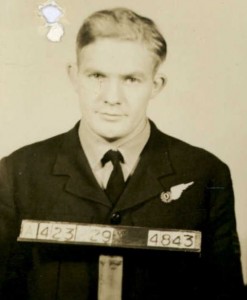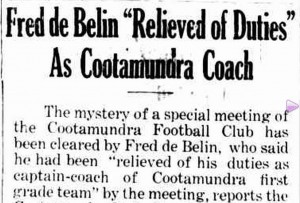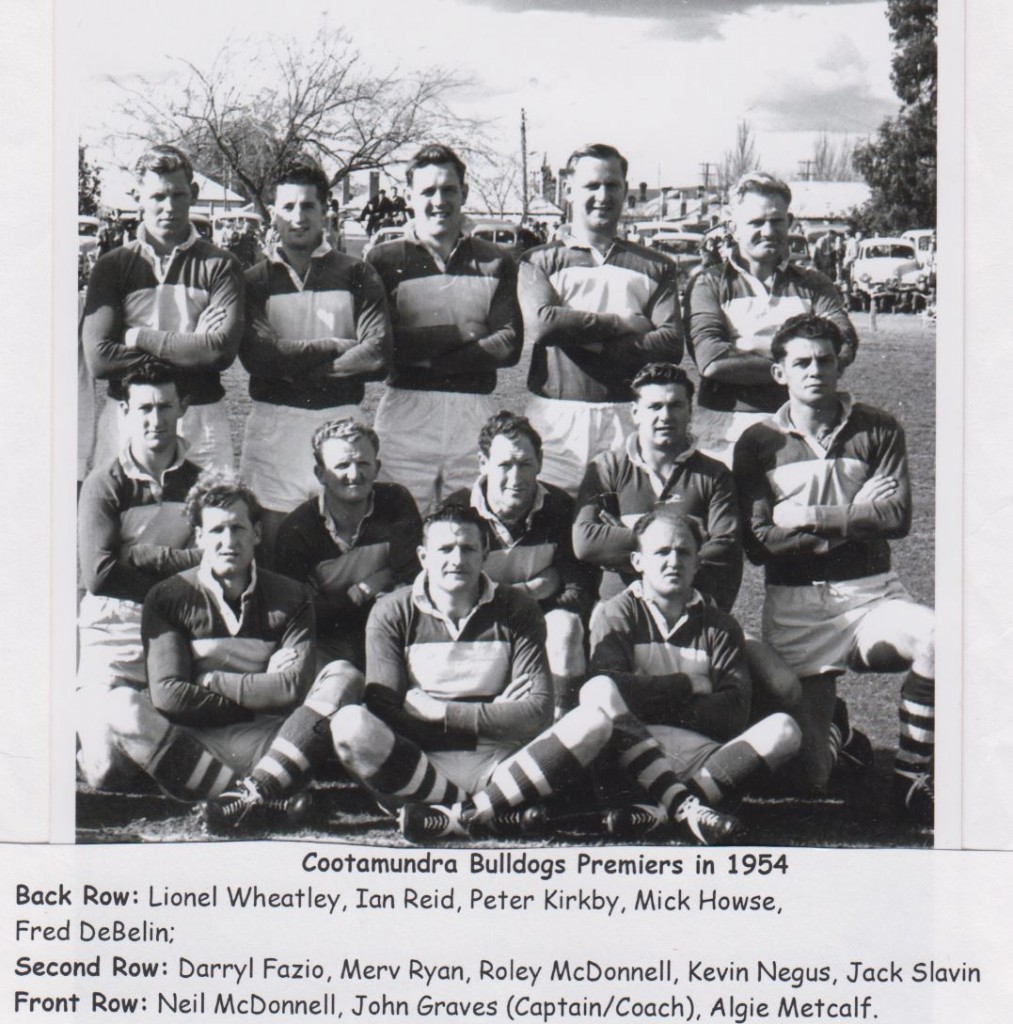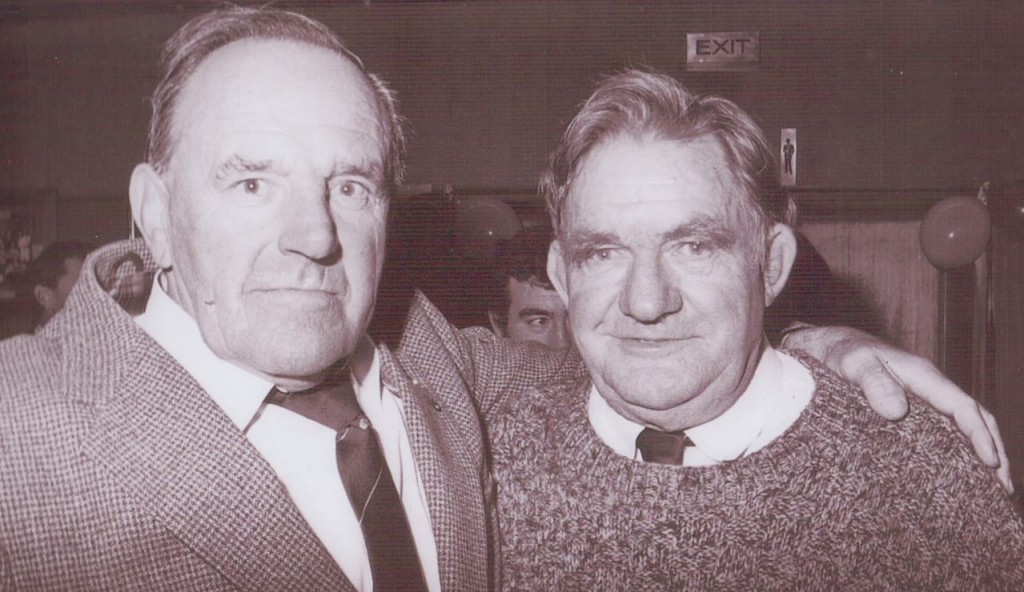After the war increasingly enormous efforts were made to wrest the Holy Grail and awash local pubs, cafes and sundry businesses in Maher Cup money.
Legendary internationals with plenty of fire still in the bellies went west in the late 1940s – Joe Jorgenson to Junee, Herb Narvo to Cootamundra, Clem Kennedy to Grenfell, Nevyl Hand to Gundagai and George Watt to Boorowa. Barmedman scored probably the best man never to play for his country – Tom Kirk. The results were mixed. Narvo, Watt and Kennedy brought the Cup home – albeit all briefly. Jorgenson disappeared. Hand failed and was replaced – but phoenix-like became the inspirational leader of possibly the best side ever formed in country NSW. Fred De Belin, Kangaroo and partner with Harry Bath in the second row of Balmain’s 1946 premiership winning team, was intending to follow suit. In early 1951, aged 30 he married in Sydney and was looking towards extending his career in a country town. In those days that was where the money was for a player with a reputation. Representations were made to Temora, a town familiar to Fred.
Ten years prior, as the nation was preoccupied with external threats, players were enlisting. De Belin joined the RAAF as part of the Empire Air Training Scheme – not a move for the feint-hearted. He spent some months in the summer and autumn of 1942-43 training on the airfields of Temora and Cootamundra. At Temora he was to be a pilot but transferred to the Air Observers School at Cootamundra where navigators were created. He received further training in Canada – changing course to the very specialist role of ‘bomb aimer‘. And then to England and into the cauldron. He flew the maximum number of 30 bombing missions over Germany, in a Lancaster named H of Harry, rising rapidly in the ranks to Flying Officer.
As if this still didn’t provide him with a big enough does of adrenalin, the golden haired lad from Rowntree Street, Balmain, already the NSW amateur wrestling champion, found enough time to secure the combined Australian services light heavyweight boxing title. He also played Rugby Union at the end of the war in an Australian airmen’s team in England, Wales and France, returning to Britain with the Kangaroos at the end of 1948.
In 1950 in Maher Cup country the most cashed up club was not Temora, but Cootamundra. Coota had developed a great team of locals – featuring a skillful back line. Starting with coach Narvo in 1947 and continuing with Bob Hobbs, Jack ‘Duck’ Walsh, and Keith Tull they were, coming into 1951 still arguably the best team in Group 9. They had been the champions in 1947, 1948 and 1950 – and held the Maher Cup for 10 weeks in 1949 – before being defeated by a Barmedman side coached by Tom Kirk.
Cootamundra, as always, were also one of the hungriest clubs. They gazumped Temora for De Belin with an unprecedented two year contract of £450 a year plus all living expenses. Coota punters became excited with the prospect that the days of utter dominance experienced with Phil Regan and Eric Weissel back in the 1920s may return.
But Cootamundra didn’t fare well in the Cup draw, being placed second last and needing to wait until 7th July. On that day “a continuous line of cars” headed on wet roads northwest towards Temora and then on to the village of Barmedman. Upwards of 3,000 folk arrived – at least five times the regular population. Most of these would have headed into the Royal, Barmedman or Queensland establishments for libations, before wandering a 100 yards to a paddock dubbed the ‘recreation ground’. There the second biggest ‘gate’ to date in Maher Cup history gathered. In the ‘Battle of the Lake’ the Clydesdale’s team of hefty forwards, helped by mud and more mud, withstood Cootamundra’s brilliant line of backs. It ended 5 all. That was Coota’s one and only chance in 1951.
Captain-coach Fred De Belin did not play at Barmedman. He had been injured and was sidelined for several weeks. Coaching Coota at the time was a precarious occupation – somewhat similar to the English Premier League today. In August, after a fresh Coota team lost a Sunday game to a Young side backing up from a grueling Maher Cup at Gundagai, the curtain fell. As De Belin put it:
The reason for my dismissal I know is that I was not playing as well as expected. Here in Cootamundra it is a crime to lose a game. The public has been so flushed by the successes of previous years that it can’t face the possibility of defeat. I have not really enjoyed playing with the firsts because of the attitude taken when a game was lost. Football is taken too seriously by the committee men. The players are afraid to lose a match and that has a bad effect on their play. The committee have panicked over recent defeats, and I have been made the scapegoat.
So Fred stayed on and coached the reserve grade and later the Bethungra village team. He became manager of the Cootamundra Baths, led a team of basketballers to the finals and became the town’s table tennis champion. In 1952 he went back to Sydney for a successful leg operation.
Fred returned to the forwards for Cootamundra in 1953 at the time when Maher Cup fever permeated everyday life everywhere in Maher Cup country. The year 1954 is still remembered with particular fondness by Cootamundra’s aficionados. Johnny ‘Whacker’ Graves from Souths led the team. A strong outfit of locals was supplemented by fullback Ian Reid, snatched from Harden; Darrell Fazio, Algy Metcalf and Lionel Wheatley who had all gone bush from Newtown; and ace hooker ‘Roley’ Negus who came down from Cowra.
On 22 May 1954 at Temora as the Cootamundra Herald reported it: Cootamundra turned on a brilliant brand of football to bring home the Maher Cup. Fred was again a hero. Fred himself listed it as his “most memorable game”, which is pretty impressive for someone who was part of the Kangaroo teams for three years and helped Balmain to secure two premierships. No bigger crowd has seen a Maher Cup match since.
Fred De Belin stayed in Coota raising his family, doing some refereeing and being a selector for Group 9.
He had many friends, and shared a close bond with fellow world war veteran, Kangaroo representative, Maher Cup hero, Cootamundra resident, and later in life lover of lawn bowls and fishing – Nevyl Hand.
A tough footballer he was described by ‘Scoop’ Sullivan in the Gundagai Independent as a “man of quiet, even gentle personality” but with a mischievious sense of humour.
A humble bloke he died peacefully at his Queen Street Cootamundra home aged 85 in 2006.
Jack De Belin, grandson and St George lock, has said.
Even when we were watching footy on Friday nights or Sunday afternoons – and we watched a lot of footy together – he never talked about anything he did or how things were back in the old days. He would discuss the televised game with you. Might say which players he rated. But that was it.
In his eulogy Jack said:
He only looked for the good in people and was always a soft touch for a stray dog.
As the courtege left the church a plane’s vapour trail slid across the sky.
- Sources, other than those linked above:
- Jack De Belin would probably be able to knit better if wasn’t for his grandfather. Daily Telegraph, Mar 30, 2012, p142
- Kogoy, Peter. Hall of Fame listing too late for Tigers great. The Australian, 13 February 2006
- Lane, Daniel. The war hero who couldn’t be baited. Sydney Morning Herald, 22 April 2012
- Obituary: Fred Leslie De Belin: final salute to airman, RL star. Cootamundra Herald, February 2006
- Passing of a legend: Fred De Belin dies peacefully at home. Gundagai Independent, 13 February 2006






Thank you for your article. I was at school with the younger Fred de Belin. They are a great family. I hope Jack continues to do well in football.